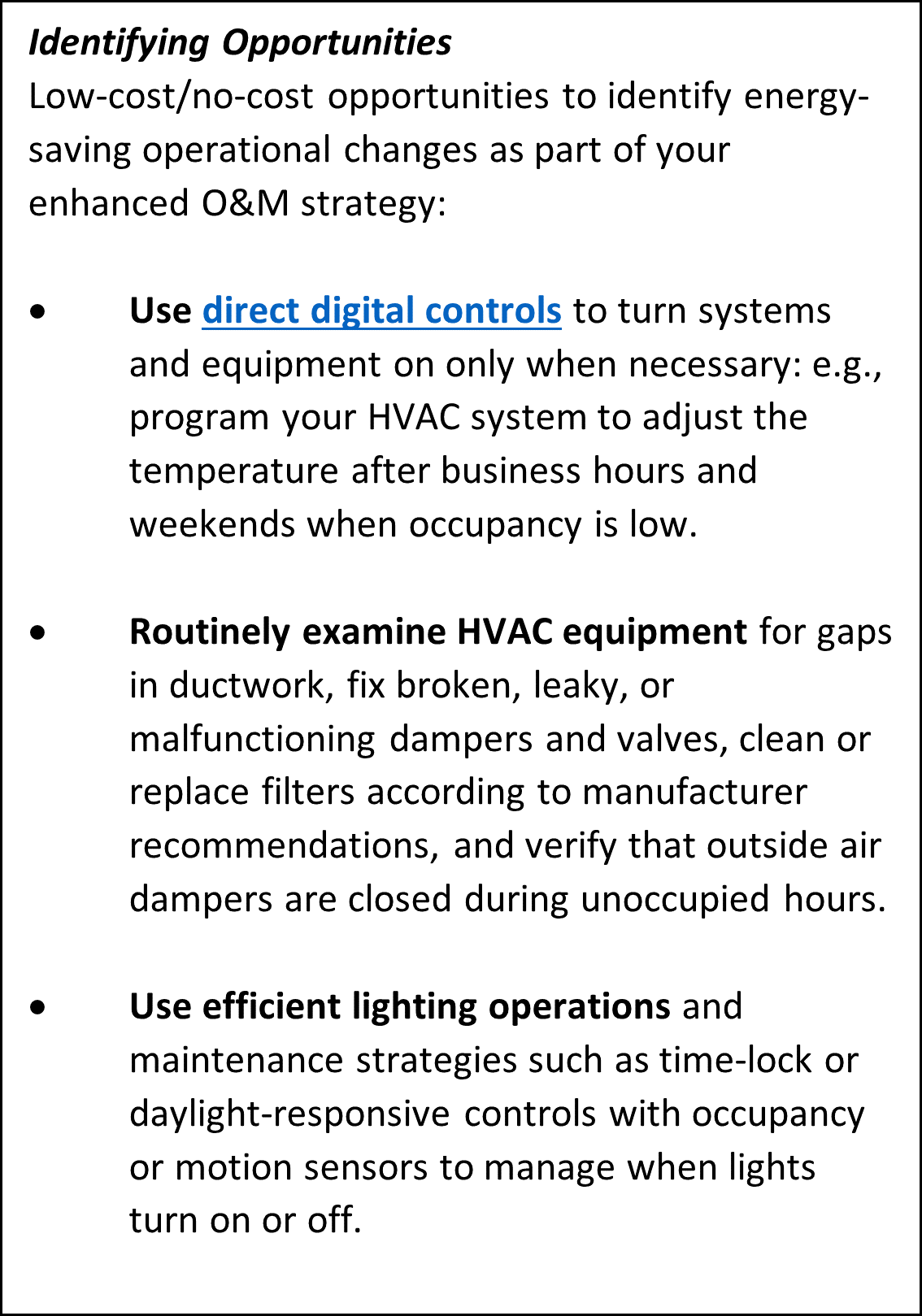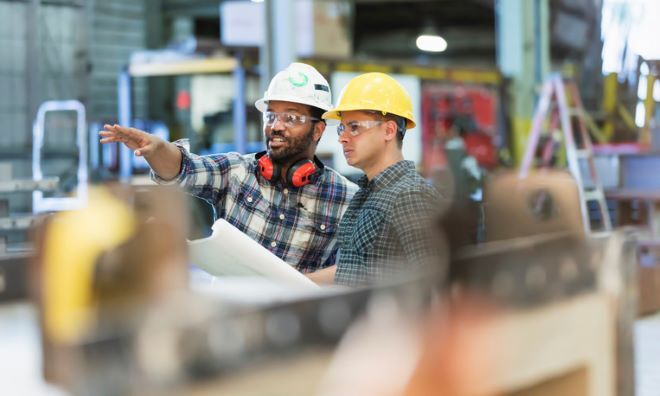Building performance often declines without a plan to continuously evaluate and maintain energy performance after improvements are made. The complexity of today’s building systems and equipment can challenge even the most experienced and tech-savvy staff. Because a building’s energy performance is largely driven by the behavior of its operators and occupants, having an effective operations and maintenance (O&M) program is imperative.
In general, building operators are the team or teams of people who ensure the day-to-day functionality of the facility, such as superintendents, engineers, property managers or management companies, and janitorial staff. People in these roles often find themselves reacting and responding to tenant issues, patching or repairing infrastructure, or finding workarounds to solve immediate issues—all of which are typically inefficient, miss opportunities for longer-term savings, and don’t proactively improve the building’s overall performance.
There are many reasons why successful building owners invest in effective O&M practices. Two key reasons are to deliver user comfort and satisfaction, and to ensure persistent energy cost savings. In many places across the U.S., owners are required to track and report ongoing energy consumption data using tools such as EPA’s ENERGY STAR® Portfolio Manager. Additionally, there is increasing adoption of building performance standards—as a way to comply with local, state, and federal regulations, and/or make their properties more attractive to potential occupants—which establish minimum operating criteria and targets for reducing the carbon impact of existing buildings.
Tracking energy performance over time can be one of the best ways to evaluate the operation of a building and detect systems that may require replacement or modifications. Effective operations can help owners meet building performance objectives, whether regulatory or enterprise-defined standards, while ensuring building systems are operating effectively and are maintained to run properly. These practices can extend system life and serve as a basis for identifying and prioritizing equipment for replacement with newer, more efficient, and cleaner technology that helps meet sustainability and carbon reduction goals over time.
A well-executed plan includes identifying financial resources to support the project, having the right team in place, and mitigating pitfalls, as mentioned in previous building renewal articles. It must also include a thorough O&M program that keeps the skills of the building operator in mind, while offering opportunities to build new proficiencies and adopt new practices to optimize building performance.
Your O&M Program
To create a high-performance portfolio, building operators need to help staff shift from being reactive to proactive. Managing buildings is not just an issue of keeping equipment working, but one of considering when, how, and why it operates.
O&M helps make this transition by focusing on improving performance with specific operational changes, robust management practices, and well-defined goals. It consists of daily and ongoing practices by building engineers, outside service firms, and key individuals to sustain performance levels over time. A thoughtful O&M program also anticipates problems and proactively addresses equipment issues before they affect performance, and will improve and maintain energy efficiency, equipment reliability, and the safety of your building systems. This should include alignment with organizational policies around economic performance, sustainability, and mission.
In a sense, it locks in energy performance obtained through building tune-ups or upgraded equipment, such as very high efficiency dedicated outdoor air systems or a luminaire level lighting control system. For buildings seeking certification such as Leadership in Energy and Environmental Design or ENERGY STAR, the sustained operational performance has become a mandatory reporting component of the certification process. Similarly, buildings in some areas—including Washington state—require regular building tune-ups, reporting, and compliance with energy performance standards. Falling short on these requirements leaves operators subject to financial penalties for non-compliance.

Training & Education
O&M staff can play a significant role in meeting building performance standards and informing building investment decision-makers of opportunities for improvement. A successful O&M program also consists of ongoing activities that help prevent equipment failure or decline. To make this a reality, you need to build staff capabilities with training and professional development. For complicated building system upgrades, routine educational workshops can help sustain high performance. Building operators should be trained to proactively target improvements and act based on observations made during day-to-day activities. Training can include individualized instruction based on staff members’ specific skillsets and/or group seminars on energy-efficient operations.
Pay specific attention to educating staff on using time-saving and proven technologies such as energy management systems. In theory, costs accrued from organizing training sessions or staff certifications are recouped through consistent high building performance, lower resource costs, and improved user satisfaction.
Skilled internal staff may be qualified to implement an enhanced O&M program; however, outside expertise often brings valuable new perspectives and experience. While building operators have many responsibilities competing for their attention, consultants and service providers can focus exclusively on O&M best practices. To augment existing staff with service providers, coordinate a review of current practices with all parties. Ensure service providers closely communicate and collaborate with your building operators. In many cases, front-line engineers and facility managers have already identified problems and issues that merit further study.
Key Components
Here are important actions you should take to ensure a successful, sustainable, O&M program:
- Perform ongoing basic maintenance: Regular and consistent maintenance is the starting point to ensure high performance levels. Develop your maintenance plan by inventorying equipment, outlining specific tasks associated with each system, and creating a schedule with accountability for each item.
- Track and report building energy use regularly: Monitoring monthly energy consumption and benchmarking against other properties gives you an informative picture of whole-building performance. Involve building operators in developing a reporting system and factor in relevant changes—such as occupancy levels, or tenant comfort and satisfaction—that may affect its energy efficiency and performance.
- Review and improve system documentation: Existing system records such as drawings, control sequences, repair histories, test and balance reports, and O&M manuals may not reflect actual conditions. Inventory current system materials and assess their comprehensiveness, accessibility, and relevance.
- Plan for the lifecycle of the building: Identify a capital planning roadmap for an integrated system replacement over the long haul. Establish anticipated replacement timeframes for major systems approaching end-of-life. Plan for the building’s performance over the next 10 to 15 years. How much energy will it use? How does this implicate O&M?
- Monitor key performance indicators for equipment and systems: Identify what data is available and define measurable KPIs to so you understand how your building operations and important systems are performing. This could include broader metrics such as energy use per square foot or number of tenant complaints, or more specific items like tons of chiller cooling produced, boiler combustion efficiency, or equipment run hours.
- Regularly assess O&M activities and management routines: An enhanced O&M plan should include procedures for periodically reviewing operating sequences, strategies, and schedules—and making revisions as necessary. As O&M improvement opportunities are identified, update practices to capture potential savings.
When developing your O&M program, remember to examine the results from scoping studies and building tune-ups. In some cases, physical inspection of the property may identify other opportunities for energy savings or better management practices.
Additional Resources
Check out the Building Renewal Series on BetterBricks.com to learn more about this important, comprehensive process:
